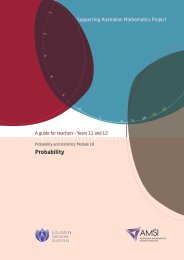Quadratics - the Australian Mathematical Sciences Institute
Quadratics - the Australian Mathematical Sciences Institute
Quadratics - the Australian Mathematical Sciences Institute
Create successful ePaper yourself
Turn your PDF publications into a flip-book with our unique Google optimized e-Paper software.
A guide for teachers – Years 11 and 12 • {35}<br />
Exercise 17<br />
Perform <strong>the</strong> algebra suggested above to derive <strong>the</strong> equation of <strong>the</strong> ellipse.<br />
If, instead, we require <strong>the</strong> difference of <strong>the</strong> distances PF 1 − PF 2 to be a fixed constant 2a,<br />
<strong>the</strong>n we obtain part of a hyperbola. The equation has <strong>the</strong> form x2<br />
a 2 − y 2<br />
b 2 = 1.<br />
y<br />
P<br />
y<br />
x 2<br />
y 2<br />
a<br />
– = 1<br />
2 b 2<br />
F1<br />
PF1 – PF2 = 2a<br />
F2<br />
x<br />
x<br />
Locus definition of <strong>the</strong> hyperbola.<br />
Locus definition of <strong>the</strong> hyperbola.<br />
Focus-directrix definitions<br />
Recall that <strong>the</strong> parabola can be defined as <strong>the</strong> locus of <strong>the</strong><br />
point P moving so that <strong>the</strong> distance PS, from P to <strong>the</strong> focus<br />
S, is equal to <strong>the</strong> perpendicular distance of P to <strong>the</strong><br />
y<br />
P<br />
D<br />
directrix l. Thus, if D is <strong>the</strong> nearest point on l to P, we<br />
have PS = PD, which we can write as PS<br />
PD = 1.<br />
The ellipse and <strong>the</strong> hyperbola also have focus-directrix<br />
definitions.<br />
We choose a fixed point S, which will be <strong>the</strong> focus, and a<br />
line l (not containing S). Take <strong>the</strong> locus of all points P such<br />
that, if D is <strong>the</strong> nearest point on l to P, <strong>the</strong>n <strong>the</strong> ratio of <strong>the</strong><br />
distances PS<br />
PD<br />
is equal to a fixed positive number e, called <strong>the</strong> eccentricity.<br />
PS<br />
PD<br />
= e<br />
S<br />
l<br />
x<br />
• If e is equal to 1, <strong>the</strong>n we have, of course, <strong>the</strong> parabola. The name parabola comes<br />
from <strong>the</strong> Greek meaning ‘fall beside’ since, in <strong>the</strong> case of <strong>the</strong> parabola, <strong>the</strong> distance<br />
PS is equal to (i.e., falls beside) <strong>the</strong> distance PD.<br />
• If e is less than 1, <strong>the</strong>n we obtain an ellipse (from <strong>the</strong> Greek meaning ‘fall short of’ —<br />
<strong>the</strong> original sense was that PS falls short of PD).<br />
• If e is greater than 1, <strong>the</strong>n we have a hyperbola (from <strong>the</strong> Greek meaning ‘exceed’ —<br />
<strong>the</strong> original sense was that PS exceeds PD).
















